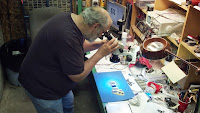The last few days, I have been in "
Router Hell" or "
Router Heaven", with a little
Amateur Radio thrown in ( but, . . . it all depends on your perspective ! ).
I have two "routers", one in my Shop/Hanger, and one in my Boathouse. The two sites are about 12 miles apart. Each router has had it own difficulties that I should have corrected before this.
For the last few months (actually longer than that), I have been having problems with my Shop network. It sometimes would get very slow, my connection from the Shop to the Internet is via;
- First, a short RF hop to my neighbors house,
- another RF longer hop to the local ISP house.
- and then a long RF link to a mountain about 10 miles away,
- then another RF Link back down the mountain (another 10 miles) to the Longhaul ISP servers shop,
- and then wires into the city of Everett, where it finally meets the Internet.
As you can see it is not exactly a pretty sight.
But, because I do NOT have good tools or insight to the actual Radio Links, it is difficult for me to test the network and know where there is difficulty. Just when I feel I-have-had-enough, it starts working very well and I forget my frustrations.
The WiMax connection at the Boathouse is also slow, but I attributed that to my CLEAR Wire Modem location, which is necessarily located in a window between metal boathouses, with only a small RF window to an unknown tower location. Sometime it is slow and miserable to work with. The Boathouse Router/WiFi Access Point (WRT-54G) is directly connected to the CLEAR modem. The Security Configuration prevents others from using my allotted bandwidth.
Then, it finally it happened, . . . the Shop/Hanger Router stopped working, a 100% Failure - it was NOW time to fix things.
My local ISP (a support guy in the airpark), gave me another "used and different router" to try. He provide the basic configuration and checkout, but I would have to configure it for the "non-standard" way that I use routers. At first, it seamed difficult to find the router admin web pages to configure the functions that I needed. But a Google search (to the rescue) provided the information I needed, and a lot, -
LOT more. My "new" router is a "
Buffalo WHR-G54S Air Station" and it uses an Open System operating system, known as "
DD-WRT".
With the new found information, I was able to easily configure my router with:
- WiFi Station Channel and Security
- NAT (Network IP Address Translation)
- PAT (Application Port Address Translation and Redirection)
- DHCP
- DHCP, with some preassigned Static IP for a few devices
Google provided lot of additional information, like; how the DD-WRT can be downloaded to many standard commercial routers - Including the router that I use a the Boathouse.
One difficulty that I had in the past with my old router at the Boathouse, I could not configure my router to do "PAT" and therefore I could only have one device that would occupy a single inbound port. For example: "ssh" uses port 22, but I wanted to place several devices (e.g., Raspberry Pie and Beaglebone computers) in the Boathouse. I could have done it, but each would have to be specially configured to use yet another port for similar services. Which means each would be unique and difficult to quickly manage. Ideally, port management is done via "PAT" in the router where it belongs. My dumb old Boathouse router can not do "PAT".
Plus, by the end of the month, CLEAR will no longer support Static IP for my area, I will have to reconfigure my Domain Name to use Dynamic DNS, that is if I want to continue to use and access the Boathouse via "network known" addresses. I have already figured out the necessary changes to the CLEAR modem configuration.
So, I downloaded the Open Source "DD-WRT" for my router, with "only" some difficulties. I now have a new OS running on my router in the Boathouse, using all of the above service and configurations. I have already moved my Rpi web server to its new location, with a little Dynamic DNS service magic, it appears as always at: "
http://rpi.wa0uwh.com:8040".
Google also provided another interesting Amateur Radio use of routers, via the Open Source efforts started by the DD-WRT group. The routers are being reconfigured as a "
Mesh Network", very similar to the old "Packet Radio" network (I think I have my facts straight). As it turns out WiFi channels 1-6 overlap the Amateur Band, and therefore the devices can be used via "part 97". I need to learn more about this.
So, a short story - made long, after several days of work, . . . all-is-well with my routers (or as good they have ever has been).
Now, it is time for more reading about "
Northwest Mesh Networks" !
--




































